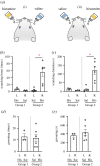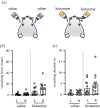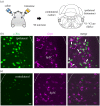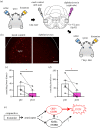Footedness for scratching itchy eyes in rodents
- PMID: 36259204
- PMCID: PMC9579771
- DOI: 10.1098/rspb.2022.1126
Footedness for scratching itchy eyes in rodents
Abstract
The neural bases of itchy eye transmission remain unclear compared with those involved in body itch. Here, we show in rodents that the gastrin-releasing peptide receptor (GRPR) of the trigeminal sensory system is involved in the transmission of itchy eyes. Interestingly, we further demonstrate a difference in scratching behaviour between the left and right hindfeet in rodents; histamine instillation into the conjunctival sac of both eyes revealed right-foot biased laterality in the scratching movements. Unilateral histamine instillation specifically induced neural activation in the ipsilateral sensory pathway, with no significant difference between the activations following left- and right-eye instillations. Thus, the behavioural laterality is presumably due to right-foot preference in rodents. Genetically modified rats with specific depletion of Grpr-expressing neurons in the trigeminal sensory nucleus caudalis of the medulla oblongata exhibited fewer and shorter histamine-induced scratching movements than controls and eliminated the footedness. These results taken together indicate that the Grpr-expressing neurons are required for the transmission of itch sensation from the eyes, but that foot preference is generated centrally. These findings could open up a new field of research on the mechanisms of the laterality in vertebrates and also offer new potential therapeutic approaches to refractory pruritic eye disorders.
Keywords: footedness; gastrin-releasing peptide receptor; histamine; itchy eyes.
Conflict of interest statement
We declare we have no competing interests.
Figures






Similar articles
-
Function of gastrin-releasing peptide receptors in ocular itch transmission in the mouse trigeminal sensory system.Front Mol Neurosci. 2023 Nov 30;16:1280024. doi: 10.3389/fnmol.2023.1280024. eCollection 2023. Front Mol Neurosci. 2023. PMID: 38098939 Free PMC article.
-
Physiological function of gastrin-releasing peptide and neuromedin B receptors in regulating itch scratching behavior in the spinal cord of mice.PLoS One. 2013 Jun 24;8(6):e67422. doi: 10.1371/journal.pone.0067422. Print 2013. PLoS One. 2013. PMID: 23826298 Free PMC article.
-
FGF13 Is Required for Histamine-Induced Itch Sensation by Interaction with NaV1.7.J Neurosci. 2020 Dec 9;40(50):9589-9601. doi: 10.1523/JNEUROSCI.0599-20.2020. Epub 2020 Nov 10. J Neurosci. 2020. PMID: 33172979 Free PMC article.
-
Itch signaling in the nervous system.Physiology (Bethesda). 2011 Aug;26(4):286-92. doi: 10.1152/physiol.00007.2011. Physiology (Bethesda). 2011. PMID: 21841076 Free PMC article. Review.
-
Mediators of Chronic Pruritus in Atopic Dermatitis: Getting the Itch Out?Clin Rev Allergy Immunol. 2016 Dec;51(3):263-292. doi: 10.1007/s12016-015-8488-5. Clin Rev Allergy Immunol. 2016. PMID: 25931325 Review.
Cited by
-
Function of gastrin-releasing peptide receptors in ocular itch transmission in the mouse trigeminal sensory system.Front Mol Neurosci. 2023 Nov 30;16:1280024. doi: 10.3389/fnmol.2023.1280024. eCollection 2023. Front Mol Neurosci. 2023. PMID: 38098939 Free PMC article.
References
Publication types
MeSH terms
Substances
LinkOut - more resources
Full Text Sources
Research Materials

